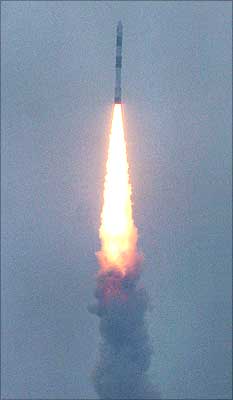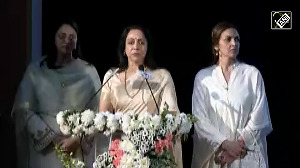 India on Monday created history by launching ten satellites in one go with its Polar launch vehicle carrying the heaviest payload of 824 kg.
India on Monday created history by launching ten satellites in one go with its Polar launch vehicle carrying the heaviest payload of 824 kg.
The ten-pack launch of the Indian Space Research Organisation saw the 230-tonne Polar Satellite Launch Vehicle (PSLV-C9) put into orbit an Indian Mini Satellite and eight foreign nano satellites besides the Cartosat-2A remote sensing satellite.
This is the first time that ISRO has put ten satellites into orbit in a single launch.
A Russian rocket in 2007 delivered 16 satellites in the outer space but the Russian launch vehicle carried a lesser payload of only around 300 kg.
"We have shown the world we can have multiple launches carried out in a precise manner. We have set a record. Only Russia has so far tried to launch 13 satellites in a single launch and I am not sure whether that was successful," ISRO chairman G Madhavan Nair.
He said there were some anxious moments due to some unusual weather conditions over the Bay of Bengal off the Andaman coast. "Only at 11 pm last night we decided to go ahead with the launch".
Nair expressed happiness that all the mission objectives were achieved with precision and all systems functioned very well.
"The PSLV-C9, in its total flight of 1,151 seconds, has performed extremely well. It's much better than a text book performance. Every system functioned as per the parameters," Nair said.
The CARTOSAT-2A and with IMS-1, followed by the nano satellites were released in quick succession, he said.
"We have received information from international customers that they have received signals from the satellites at their ground stations. The mission stations at Thiruvananthapuram and Mauritius have also received information that the satellites are in good health and we hope that if everything goes right within the next two days, we would be able to switch on the imaging system," Nair said.
He said while $0.6 million was charged for the nano satellites, it cost around Rs 120 crore for the CARTOSAT and Rs 22 crore for the IMS-1.
The launch comes ahead of India's plans to launch its first moon mission - Chandrayaan-I - expected later this year.
On the Chandrayaan Mission, Nair said a modest satellite, weighing about 500 kg, would be launched into the lunar orbit to collect topographical data of the moon.
"We hope by the third quarter of this year, we should be able to take a satellite to the moon," he said.
He said ISRO planned to induct indigenous cryogenic stage into the GSLV soon.
Vikram Sarabhai Space Centre director K Radhakrishnan, who was also present at the launch, said ISRO had started designing space capsules to send two astronauts on a low earth orbit in the next seven years for the manned mission to space.
Considering the safety of the crew and vehicle, which will be the GSLV, the design aspects were taken up very seriously and there would be an unmanned mission before sending the astronauts, Radhakrishnan said.
"The man mission is necessary for the country as the US, Russia, China and some major European countries already in the scenario as prominent players," he said.
Before the manned mission, there would be three unmanned missions which would be undertaken BY GSLV MK-III. The government had already made an initial allotment of Rs 95 crore for the mission, he said.
The PSLV blasted off from the second launch pad at the Satish Dhawan Space Centre at 9.24 am and fourteen minutes later, the fourth stage injected the ten satellites into the 635 km polar Sun Synchronous Orbit (SSO).
This is the thirteenth flight of PSLV and the third with the 'core-alone' configuration, without the hugging six strap-on booster motors that powers the first stage.
CARTOSAT-2A, weighing about 690 kg, carries a state-of-the-art Panchromatic camera that can record high clarity images covering a swathe of 9.6 kms. It will provide data that could be used for urban and rural infrastructure management and land information systems.
The highly agile remote sensing satellite can be manoeuvred to facilitate imaging of any area more frequently.
The 83 kg IMS-1, developed by ISRO, incorporated many new technologies and has miniaturised subsystems. Data from it will be shared with other developing countries.
The eight nano satellites, built by universities and research institutions in Canada and Germany, were launched under a commercial agreement.
Image: The PSLV-C9 soars into the sky after blasting off from the Satish Dhawan Space Centre at Sriharikota on Monday
Text & Photograph: PTI





